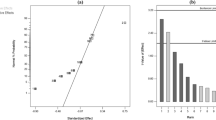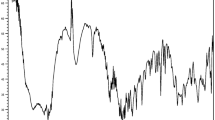Abstract
pH-sensitive lappaconitine-loaded kappa-carrageenan microparticle (LA-KCG-MP), a degradable, high-load, ionic biopolymer, was prepared using a two-step self-assembly method. Cation exchange resin was selected to degrade kappa-carrageenan (KCG). By investigating the reaction time, temperature, and resin dose, the optimum reaction conditions were determined. Degraded KCG was then easily loaded with a hydrophobic drug, lappaconitine (LA), forming lappaconitine-loaded kappa-carrageenan (LA-KCG) by electrostatic self-assembly. LA-KCG-MP can be prepared by LA-KCG using secondary self-assembly by dialysis subsequently. The loading capacity, release behavior, and pH sensitivity of LA as well as its analgesic properties were determined. Results showed that KCG could be a novel natural polymeric carrier to load a hydrophobic alkaloid, since no synthetic polymer was involved. Furthermore, the loading capacity reached up to 26 % (w/w). Also, LA loaded with KCG was released faster in an acidic environment than that in a neutral environment. The loading capacity and pH sensitivity increased with a decrease in the molecular weight of KCG. In addition, animal analgesic experiments showed that LA-KCG-MP of low molecular weight had earlier onset time and longer duration. These results suggested that KCG of low molecular weight had great potential to achieve the synergistic effect of LA.








Similar content being viewed by others
References
Aluri S, Janib SM, Mackay JA (2009) Environmentally responsive peptides as anticancer drug carriers. Adv Drug Deliv Rev 61:940–952
Bixler HJ, Porse H (2011) A decade of change in the seaweed hydrocolloids industry. J Appl Phycol 23:321–335
Campo VL, Kawano DF, da Silva DB, Carvalho I (2009) Carrageenans: biological properties, chemical modifications and structural analysis—a review. Carbohydr Polym 77:167–180
Chen HM, Yan XJ, Wang F, Xu WF, Zhang L (2010) Assessment of the oxidative cellular toxicity of a κ-carrageenan oxidative degradation product towards Caco-2 cells. Food Res Intl 43:2390–2401
Colquhoun IJ, Jay AJ, Eagles J, Morris VJ, Edwards KJ, Griffin AM, Gasson MJ (2001) Structure and conformation of a novel genetically engineered polysaccharide P2. Carbohydr Res 330:325–333
Coviello T, Matricardi P, Marianecci C, Alhaique F (2007) Polysaccharide hydrogels for modified release formulations. J Controlled Release 119:5–24
D’Ayala GG, Malinconico M, Laurienzo P (2008) Marine derived polysaccharides for biomedical applications: chemical modification approaches. Molecules 13:2069–2106
Guibet M, Kervarec N, Génicot S, Chevolot Y, Helbert W (2006) Complete assignment of 1H and 13C NMR spectra of Gigartina skottsbergii λ-carrageenan using carrabiose oligosaccharides prepared by enzymatic hydrolysis. Carbohydrate Res 341:1859–1869
Guo JH, Skinner GW, Harcum WW, Barnum PE (1998) Pharmaceutical applications of naturally occurring water-soluble polymers. Pharmaceut Sci Technol Today 1:254–261
Hurtado AQ, Montaño MNE, Martinez-Goss MR (2013) Commercial production of carrageenophytes in the Philippines: ensuring long-term sustainability for the industry. J Appl Phycol 25:733–742
Jouanneau D, Boulenguer P, Mazoyer J, Helbert W (2010) Enzymatic degradation of hybrid ι-/ν- carrageenan by Alteromonas fortis ι-carrageenase. Carbohydr Res 345:934–940
Laurienzo P (2010) Marine polysaccharides in pharmaceutical applications: an overview. Mar Drugs 8:2435–2465
Liu GL, Li Y, Chi Z, Chi ZM (2011) Purification and characterization of κ-carrageenase from the marine bacterium pseudoalteromonas porphyrae for hydrolysis of κ-carrageenan. Process Biochem 46:265–271
Mollet JC, Rahaoui A, Lemoine Y (1988) Yield, chemical composition and gel strength of agarcolloids of Gracilaria gracilis, Gracilariopsis longissima and the newly reported Gracilaria cf. vermiculophylla from Roscoff (Brittany, France). J Appl Phycol 10:59–66
Myslabodski DE, Stancioff D, Heckert RA (1996) Effect of acid hydrolysis on the molecular weight of kappa carrageenan by GPC-LS. Carbohydr Polym 31:83–92
Necas J, Bartosikova L (2013) Carrageenan: a review. Vet Med 58:187–205
Prajapati VD, Maheriya PM, Jani GK, Solanki HK (2014) Carrageenan: a natural seaweed polysaccharide and its applications. Carbohydr Polym 105:97–112
Reddy K, Mohan GK, Satla S, Gaikwad S (2011) Natural polysaccharides: versatile excipients for controlled drug delivery systems. Asian J Pharmaceut Sci 6:275–286
Relleve L, Nagasawa N, Luan LQ, Yagi T, Aranilla C, Abad L, Dela Rosa A (2005) Degradation of carrageenan by radiation. Polymer Degrad Stabil 87:403–410
Schmaljohann D (2006) Thermo- and pH-responsive polymers in drug delivery. Adv Drug Deliv Rev 58:1655–1670
Singh SK, Jacobsson SP (1994) Kinetics of acid hydrolysis of κ-carrageenan as determined by molecular weight (SEC-MALLS-RI), gel breaking strength, and viscosity measurements. Carbohydr Polym 23:9–103
Sun W, Hu Q, Ding C, Duan Y, Jia J (2011a) Crystal structure of 2-acetamido-5-bromobenzoic acid, C9H8BrNO3. Zeitschr Kristallogr 226:75–76
Sun WX, Yuan AA, Zhang CY, Dong TG (2011b) Crystal structure of acontine-4, 8, 9-triol-19-ethyl-1, 14, 16-trimethoxy-4-[2-(acetylamino) benzoate] adulterated copper chloride C32H45N2O8Cl2Cu. Adv Mat Res 236:2242–2245
Sun WX, Dong TG, Ding CM (2012) Crystal structure analysis and antinociceptive property of lappaconitine hydrochloride. Adv Mat Res 343:1049–1052
Sun W, Wang H, Zhang S, Wang X (2014) Crystal structure of lappaconitine-ium nitrate monohydrate, C32H47N3O12. Zeitschr Kristallogr 229:485–487
Xu H, Zhong H, Liu M, Xu C, Gao Y (2011) Lappaconitine-loaded microspheres for parenteral sustained release: effects of formulation variables and in vitro characterization. Die Pharmazie 66:654–661
Yuan H, Zhang W, Li X, Lü X, Li N, Gao X, Song J (2005) Preparation and in vitro antioxidant activity of κ-carrageenan oligosaccharides and their over sulfated, acetylated, and phosphorylated derivatives. Carbohydr Res 340:685–692
Yuan H, Song J, Li X, Li N, Dai J (2006) Immunomodulation and antitumor activity of κ-carrageenan oligosaccharides. Cancer Lett 243:228–234
Zhang J, Sun WX, Wen HH, Liu HS, Li HK, Yu KB, Wang YP (2007) Synthesis and crystal structure of lappaconitine hydrobromide. Chinese J Org Chem 27:1409–1413
Zhou GF, Yao WH, Wang CG (2006) Kinetics of microwave degradation of κ-carrageenan from Chondrus occelatus. Carbohydr Polym 64:73–77
Acknowledgments
This work was financially supported by the China Postdoctoral Science Foundation project (2012M520609), Specialized Research Fund for the Doctoral Program of Higher Education of China (20131515120014), Excellent Young Scientist Foundation of Inner Mongolia Agricultural University of China (2014XYQ-15), and Science and Technology Plan Projects of Lanzhou of China (2012-2-92). We also acknowledge the Natural Sciences and Engineering Research Council of Canada (NSERC).
Author information
Authors and Affiliations
Corresponding author
Rights and permissions
About this article
Cite this article
Sun, W., Saldaña, M.D.A., Zhao, Y. et al. New application of kappa-carrageenan: producing pH-sensitive lappaconitine-loaded kappa-carrageenan microparticle using two-step self-assembly. J Appl Phycol 28, 2041–2050 (2016). https://doi.org/10.1007/s10811-015-0712-4
Received:
Revised:
Accepted:
Published:
Issue Date:
DOI: https://doi.org/10.1007/s10811-015-0712-4




